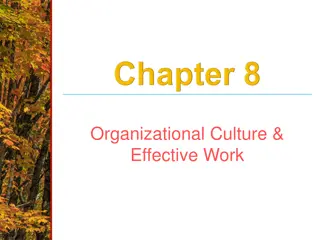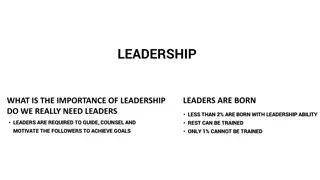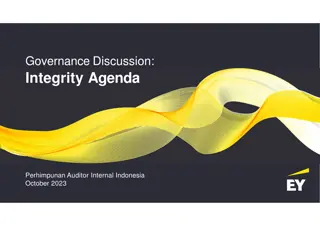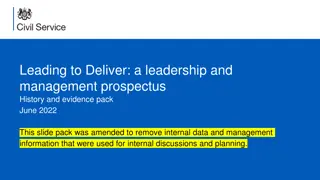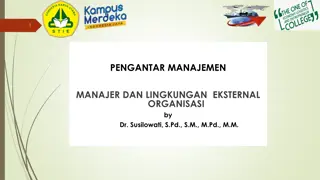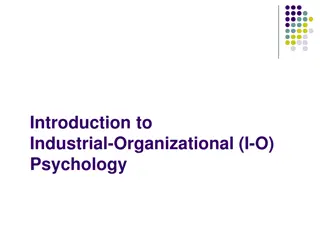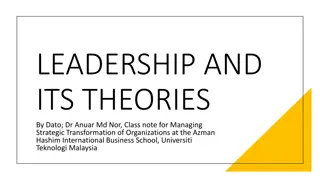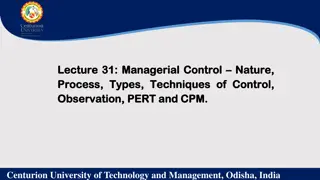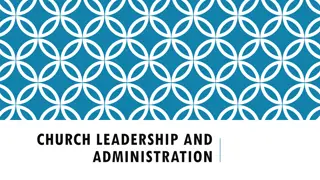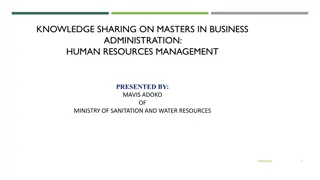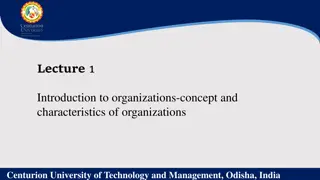Understanding Management, Leadership, and Organizational Success
The process of achieving organizational objectives through effective management and leadership is crucial for success. Management roles, such as top management, middle management, and supervisory management, each play a distinct role in implementing strategic plans and motivating employees. Skills like technical, human, and conceptual are essential for managers' success. Leadership traits like empathy, self-awareness, and objectivity are key in inspiring teams to achieve goals. Different leadership styles, such as autocratic, democratic, and free-rein, impact decision-making processes within organizations. Setting a clear vision that aligns with marketplace needs is fundamental for guiding the organization towards success in a changing business environment.
Download Presentation

Please find below an Image/Link to download the presentation.
The content on the website is provided AS IS for your information and personal use only. It may not be sold, licensed, or shared on other websites without obtaining consent from the author. Download presentation by click this link. If you encounter any issues during the download, it is possible that the publisher has removed the file from their server.
E N D
Presentation Transcript
Chapter 7 Management, Leadership, and the Internal Organization http://www.wileybusinessupdates.com
What is Management? The process of achieving organizational objectives through people and other resources.
Top Management Develop long-range strategic plans for the organization. Inspire executives and employees to achieve their vision for the company s future.
Middle Management Focus on specific operations, products, or customer groups within an organization. Responsible for developing detailed plans and procedures to implement the firm s strategic plans.
Supervisory Management Implement the plans developed by middle managers. Responsible for non- manager employees. Motivate workers to accomplish daily, weekly, and monthly goals.
Skills Needed for Management Success Technical skills Manager s ability to understand and use the techniques, knowledge, and tools and equipment of a specific discipline or department. Human skills Interpersonal skills that enable a manager to work effectively with and through people. Conceptual skills Ability to see the organization as a unified whole and to understand how each part of the overall organization interacts with other parts.
Managers as Leaders Leadership is the ability to direct or inspire people to attain certain goals. Involves the use of influence or power. Three traits are common among many leaders: Empathy Self-awareness Objectivity in dealing with others
Leadership Styles Autocratic Leadership Make decisions on own without consulting employees. Democratic Leadership Involve employees in decisions, delegate assignments, and ask employees for suggestions. Free-Rein Leadership Leave most decisions to employees.
Leading by Setting a Vision for the Firm Vision is the perception of marketplace needs and the methods an organization can use to satisfy them. Must be focused yet adaptable to changes in the business environment.
Corporate Culture Corporate Culture: Organization s system of principles, beliefs, and values. Managers use symbols, rituals, ceremonies, and stories to reinforce corporate culture.
Managers as Decision Makers Decision making is the process of recognizing a problem or opportunity, evaluating alternative solutions, selecting and implementing an alternative, and assessing the results. Delegation is the act of assigning work activities to subordinates. Providing employees with the responsibility and the necessary authority for completing tasks. Employees have accountability, or responsibility for the results of the way they perform their assignments. Authority and responsibility move down; accountability moves up.
Span of management, centralization, and decentralization Span of management is the number of subordinates, or direct reports, a supervisor manages. Centralization: decision making is retained at the top of the management hierarchy. Decentralization: decision making is located at the lower levels. Many firms believe it enhances their flexibility and responsiveness to customer needs.
Importance of Planning There are different types and levels of plans. Organizations should have a comprehensive planning framework. From mission statement to objectives and goals Narrow functional plans Plans outline the steps the company will take to meet outlined goals and objectives.
Organizational Structures Organization: structured grouping of people working together to achieve common goals. Three key elements: Human interaction Goal-directed activities Structure
Departmentalization Process of dividing work activities into units within the organization. Product departmentalization: organized based on the goods and services a company offers. Geographical departmentalization: organized by geographical regions within a country or, for a multinational firm, by region throughout the world. Customer departmentalization: organized by the different types of customers the organization serves. Functional departmentalization: organized by business functions such as finance, marketing, human resources, and production. Process departmentalization: organized by work processes necessary to complete production of goods or services.
Different Forms of Departmentalization
Types of Organization Structures Line Organizations Oldest and simplest form; direct flow of authority from CEO to subordinates. Chain of command indicates who directs which activities and who reports to whom. Line-and-Staff Organizations Combines line departments and staff departments. Line departments participate directly in decisions that affect the core operations of the organization. Staff departments lend specialized technical support.
Committee Organizations Authority and responsibility are in the hands of a group of individuals. Often part of a line-and-staff structure. Often develop new products. Tend to act slowly and conservatively. Often make decisions by compromising conflicting interests rather than choosing best alternative.
Matrix Organizations Project management structure that links employees from different parts of the organization to work together on specific projects. Employees report to a line manager and a project manager. Advantages: Flexibility in adapting to changes. Focus on major problems or products. Outlet for employees creativity and initiative. Disadvantages: Integrating skills of many specialists into a coordinated team. Team members permanent functional managers must adjust the employees regular workloads.
Managerial Functions Directing: guiding and motivating employees to accomplish organizational objectives. Includes training, setting up schedules, delegating tasks, and monitoring progress. Controlling: evaluating an organization s performance against its objectives. establish performance standards monitor actual performance compare actual performance with established standards make corrections if necessary
26 QUESTIONS? Reach out to me via email baltaklm@piercecollege.edu Or Canvas messaging.















